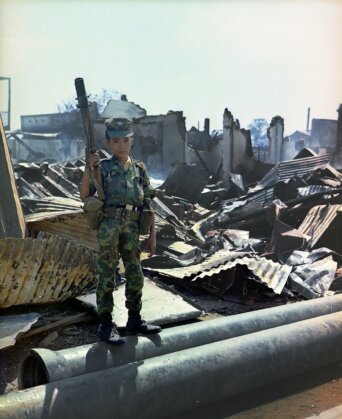- About
- Topics
- Picks
- Audio
- Story
- In-Depth
- Opinion
- News
- Donate
- Signup for our newsletterOur Editors' Best Picks.Send
Read, Debate: Engage.
| topic: | Child rights |
|---|---|
| located: | Colombia |
| editor: | Ellen Nemitz |
The history of Colombia is marked by violence. Decades of paramilitaries and rebel groups conflicts have led to over nine million people's lives lost to war, from kidnappings and murders to forced displacement. Peace is a pursued goal: in 2016, a bilateral cease-fire was signed in Havana (Cuba) by the Revolutionary Armed Forces known as FARC – who became a political party – and the government. Due to the government's failure to achieve the deal terms, according to FARC's side, a dissident group is about to retake the guns.
Although it is probably the most famous, Farc is not the only armed group in Colombia. As a poor Latin American country, the nation lives in unequal conditions that feed the conflicts. In this context, several children may be forced into the war "by force or under the impression that becoming a member will offer them an escape from grinding poverty," as explains the NGO Children Change Colombia. The institution affirms that these groups "use them as messengers, drug traffickers, fighters, informers or for sex.” The government estimates around 9 thousand victims of this crime over the past decades, but independent organisations estimates differ due to the extreme difficulties of reporting.
Amid the pandemic, child recruitment has become even more intense. A report from The New Humanitarian says that "Almost as many children are estimated to have joined armed groups in Colombia in the first half of this year as in the whole of 2019, as the economic and social fallout of the coronavirus pandemic provides fertile ground for recruiters amid a resurgence of violence and conflict." In numbers, this represents at least 190 children, in just six months, according to the Coalition Against the Involvement of Boys and Girls Youth to the Armed Conflict in Colombia (COALICO).
Violence in Colombia has followed the trail of economic crisis risen by the pandemic. Lockdown measures were useful to slow down the virus' transmission, but at the same time, it created a hunger contingent. The high unemployment or informal work rates explain at least part of the tendency of child recruitment, as families face difficulties to meet basic needs. "With this, the quarantine has revealed the situations of intrafamily violence that continue to be present and also put the lives of girls, boys and adolescents at risk,” says the COALICO’s report. An additional risk factor is the schools' closure, because education institutions may work in several parts as protection places. Also, travel restrictions might represent a barrier for organisations to go to remote areas and combat the crime.
Both Children Change Colombia and the NGO War Child Holland, among other institutions, act in the country to prevent children from being recruited by armed groups – based on poverty combating – and to reintegrate them into society. A testimony published on the latter's website portrays the importance of this work: “After joining War Child's activities, I have personally made a lot of changes. I have learned to live together with others without fighting.”
Image by janeb13

